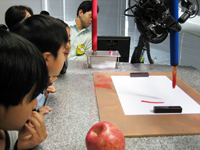Motivation
In this workshop, we intend to discuss the relationship between art and robotics. Can a robot represent art? If possible, how can this be done?
Recently, the use of humanoid robots in the entertainment field has become quite sophisticated. However, because these performances are just replays of predesigned motion, audiences soon become bored with them. Therefore, in order to use a humanoid robot in an entertainment field, it is important to develop a robot that makes a lasting impression on people.
While most studies of entertainment robots focus on motion generation, some researchers are focusing on generation of artistic expression. For example, in a dancing robot, these researchers do not merely generate dancing motion, but rather generate artistic dance performance based on analyzing the structure of the dance and identifying the factors that make humans feel the beauty of dance. These kind of studies are made in dancing, painting, and music.
In this workshop, we intend to explore the relationship between art and robotics through these art-oriented studies.
Organizers
| General chair |
Katsushi Ikeuchi (The University of Tokyo) |
| Program chair |
Ken Goldberg (University of California at Berkeley) |
| Prpgram co-chair |
Shunsuke Kudoh (The University of Tokyo) |



